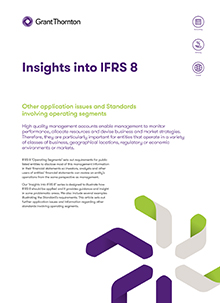-
Why Grant Thornton
Whether you’re growing in one market or many, looking to operate more effectively, managing risk and regulation, or realising stakeholder value, our firms can help.
-
Culture and experience
Grant Thornton’s culture is one of our most valuable assets and has steered us in the right direction for more than 100 years.
-
Global scale and capability
Beyond global scale, we embrace what makes each market unique, local understanding on a global scale.
-
Join our network
In a world that wants more options for high quality services, we differentiate in the market to grow sustainably in today’s rapidly changing environment.
-
Leadership governance and quality
Grant Thornton International Ltd acts as the coordinating entity for member firms in the network with a focus on areas such as strategy, risk, quality monitoring and brand.
-
Africa
24 member firms supporting your business.
-
Americas
31 member firms, covering 44 markets and over 20,000 people.
-
Asia-Pacific
19 member firms with nearly 25,000 people to support you.
-
Europe
53 member firms supporting your business.
-
Middle East
8 member firms supporting your business.
-
Business consulting services
Our business consulting services can help you improve your operational performance and productivity, adding value throughout your growth life cycle.
-
Business process solutions
We can help you identify, understand and manage potential risks to safeguard your business and comply with regulatory requirements.
-
Business risk services
The relationship between a company and its auditor has changed. Organisations must understand and manage risk and seek an appropriate balance between risk and opportunities.
-
Cybersecurity
As organisations become increasingly dependent on digital technology, the opportunities for cyber criminals continue to grow.
-
Forensic and investigation services
At Grant Thornton, we have a wealth of knowledge in forensic services and can support you with issues such as dispute resolution, fraud and insurance claims.
-
Mergers and acquisitions
We work with entrepreneurial businesses in the mid-market to help them assess the true commercial potential of their planned acquisition and understand how the purchase might serve their longer-term strategic goals.
-
Recovery and reorganisation
Workable solutions to maximise your value and deliver sustainable recovery.
-
Transactional advisory services
We can support you throughout the transaction process – helping achieve the best possible outcome at the point of the transaction and in the longer term.
-
Valuations
We provide a wide range of services to recovery and reorganisation professionals, companies and their stakeholders.

-
IFRS
At Grant Thornton, our IFRS advisers can help you navigate the complexity of financial reporting from IFRS 1 to IFRS 17 and IAS 1 to IAS 41.
-
Audit quality monitoring
Having a robust process of quality control is one of the most effective ways to guarantee we deliver high-quality services to our clients.
-
Global audit technology
Our global assurance technology platform provides the ability to conduct client acceptance, consultations and all assurance and other attestation engagements.

-
Corporate and business tax
Our trusted teams can prepare corporate tax files and ruling requests, support you with deferrals, accounting procedures and legitimate tax benefits.
-
Direct international tax
Our teams have in-depth knowledge of the relationship between domestic and international tax laws.
-
Global mobility services
Through our global organisation of member firms, we support both companies and individuals, providing insightful solutions to minimise the tax burden for both parties.
-
Indirect international tax
Using our finely tuned local knowledge, teams from our global organisation of member firms help you understand and comply with often complex and time-consuming regulations.
-
Transfer pricing
The laws surrounding transfer pricing are becoming ever more complex, as tax affairs of multinational companies are facing scrutiny from media, regulators and the public

-
 Banking Holding banking to account: the real diversity and inclusion pictureWe explore how the banking sector can continue to attract, retain and nurture women to build a more diverse and inclusive future.
Banking Holding banking to account: the real diversity and inclusion pictureWe explore how the banking sector can continue to attract, retain and nurture women to build a more diverse and inclusive future. -
 Sustainability From voluntary to mandatory ESG: How banks can future-proof their operationsAs we move from voluntary ESG initiatives to mandatory legislation, we explore what the banking sector needs to prioritise.
Sustainability From voluntary to mandatory ESG: How banks can future-proof their operationsAs we move from voluntary ESG initiatives to mandatory legislation, we explore what the banking sector needs to prioritise. -
 IFRS IFRS 9 - Audit of Expected Credit LossesGPPC releases The Auditor’s response to the risks of material misstatement posed by estimates of expected credit losses under IFRS 9
IFRS IFRS 9 - Audit of Expected Credit LossesGPPC releases The Auditor’s response to the risks of material misstatement posed by estimates of expected credit losses under IFRS 9 -
 growthiQ Steering your company to long-term successHistory has something important to tell us about the difficulties of steering a business to long-term success – through seismic shifts in technology, consumer demands and product development. With that in mind it’s unsurprising that over half the world’s largest companies in the early 1900s had shut their doors by the late 1990s. Some, however, have endured.
growthiQ Steering your company to long-term successHistory has something important to tell us about the difficulties of steering a business to long-term success – through seismic shifts in technology, consumer demands and product development. With that in mind it’s unsurprising that over half the world’s largest companies in the early 1900s had shut their doors by the late 1990s. Some, however, have endured.
-
 International Financial Reporting Standards Implementation of IFRS 17 ‘Insurance Contracts’The auditor’s response to the risks of material misstatement arising from estimates made in applying IFRS 17 ‘Insurance Contracts’
International Financial Reporting Standards Implementation of IFRS 17 ‘Insurance Contracts’The auditor’s response to the risks of material misstatement arising from estimates made in applying IFRS 17 ‘Insurance Contracts’ -
 IFRS Get ready for IFRS 17After twenty years of development the IASB has published IFRS 17 ‘Insurance Contracts’, find out more.
IFRS Get ready for IFRS 17After twenty years of development the IASB has published IFRS 17 ‘Insurance Contracts’, find out more.
-
 Global business pulse - industry analysis Mid-market recovery spreads to more industriesThe index results for 13 key industries of the mid-market reveals a very uneven recovery from COVID-19
Global business pulse - industry analysis Mid-market recovery spreads to more industriesThe index results for 13 key industries of the mid-market reveals a very uneven recovery from COVID-19 -
 Not for profit How to effectively leave the pandemic behindAs the light at the end of the COVID-19 tunnel shines brighter, nonprofits are assessing the past year’s impact on their businesses and are focusing on the next steps to achieve success in the year ahead.
Not for profit How to effectively leave the pandemic behindAs the light at the end of the COVID-19 tunnel shines brighter, nonprofits are assessing the past year’s impact on their businesses and are focusing on the next steps to achieve success in the year ahead. -
 Global business pulse - industry analysis A very uneven recovery across industriesThe index results for 13 key industries of the mid-market reveals a very uneven recovery from COVID-19
Global business pulse - industry analysis A very uneven recovery across industriesThe index results for 13 key industries of the mid-market reveals a very uneven recovery from COVID-19 -
 Global business pulse - Sector analysis Clear patterns of damage from COVID-19 across the industriesThe index results for 12 key sectors of the mid-market reveal just how much or little the various parts of the economy were impacted by COVID-19.
Global business pulse - Sector analysis Clear patterns of damage from COVID-19 across the industriesThe index results for 12 key sectors of the mid-market reveal just how much or little the various parts of the economy were impacted by COVID-19.
-
 Private equity ESG for private equityMost US private equity firms are taking steps, prompted by a combination of European examples, imminent regulation, limited partner expectations, and their own sense of what needs to be done.
Private equity ESG for private equityMost US private equity firms are taking steps, prompted by a combination of European examples, imminent regulation, limited partner expectations, and their own sense of what needs to be done. -
 Access to finance Raise finance to invest in changePrepare your business to raise finance to invest in change.
Access to finance Raise finance to invest in changePrepare your business to raise finance to invest in change. -
 Private equity firms Private equity in the mid-market: reshaping strategies for 2021When the global COVID-19 pandemic stormed across the globe in early 2020, the private equity sector was hit hard but deals are coming back to the market.
Private equity firms Private equity in the mid-market: reshaping strategies for 2021When the global COVID-19 pandemic stormed across the globe in early 2020, the private equity sector was hit hard but deals are coming back to the market. -
 Mid-market businesses Getting ready for private equity investmentOur specialists explore how private equity firms are now working with their portfolios and how the mid-market can benefit from investment.
Mid-market businesses Getting ready for private equity investmentOur specialists explore how private equity firms are now working with their portfolios and how the mid-market can benefit from investment.
-
 Public sector Helping build the government of tomorrow, todayLearn about the Grant Thornton US public sector team.
Public sector Helping build the government of tomorrow, todayLearn about the Grant Thornton US public sector team. -
 Global business pulse - industry analysis Mid-market recovery spreads to more industriesThe index results for 13 key industries of the mid-market reveals a very uneven recovery from COVID-19
Global business pulse - industry analysis Mid-market recovery spreads to more industriesThe index results for 13 key industries of the mid-market reveals a very uneven recovery from COVID-19 -
 Global business pulse - industry analysis A very uneven recovery across industriesThe index results for 13 key industries of the mid-market reveals a very uneven recovery from COVID-19
Global business pulse - industry analysis A very uneven recovery across industriesThe index results for 13 key industries of the mid-market reveals a very uneven recovery from COVID-19 -
 Global business pulse - Sector analysis Clear patterns of damage from COVID-19 across the industriesThe index results for 12 key sectors of the mid-market reveal just how much or little the various parts of the economy were impacted by COVID-19.
Global business pulse - Sector analysis Clear patterns of damage from COVID-19 across the industriesThe index results for 12 key sectors of the mid-market reveal just how much or little the various parts of the economy were impacted by COVID-19.
-
 Industries European Real Estate PodcastJessica Patel, Tax Partner at Grant Thornton UK speaks with tax partners and directors across the network to share their insights on the real estate market and some of the challenges.
Industries European Real Estate PodcastJessica Patel, Tax Partner at Grant Thornton UK speaks with tax partners and directors across the network to share their insights on the real estate market and some of the challenges. -
 Industries European Real Estate PodcastJessica Patel, Tax Partner at Grant Thornton UK speaks with tax partners and directors across the network to share their insights on the real estate market and some of the challenges.
Industries European Real Estate PodcastJessica Patel, Tax Partner at Grant Thornton UK speaks with tax partners and directors across the network to share their insights on the real estate market and some of the challenges. -
 Global business pulse - industry analysis Mid-market recovery spreads to more industriesThe index results for 13 key industries of the mid-market reveals a very uneven recovery from COVID-19
Global business pulse - industry analysis Mid-market recovery spreads to more industriesThe index results for 13 key industries of the mid-market reveals a very uneven recovery from COVID-19 -
 Global business pulse - industry analysis A very uneven recovery across industriesThe index results for 13 key industries of the mid-market reveals a very uneven recovery from COVID-19
Global business pulse - industry analysis A very uneven recovery across industriesThe index results for 13 key industries of the mid-market reveals a very uneven recovery from COVID-19
-

-
 Global business pulse - industry analysis Mid-market recovery spreads to more industriesThe index results for 13 key industries of the mid-market reveals a very uneven recovery from COVID-19
Global business pulse - industry analysis Mid-market recovery spreads to more industriesThe index results for 13 key industries of the mid-market reveals a very uneven recovery from COVID-19 -
 Global business pulse - industry analysis A very uneven recovery across industriesThe index results for 13 key industries of the mid-market reveals a very uneven recovery from COVID-19
Global business pulse - industry analysis A very uneven recovery across industriesThe index results for 13 key industries of the mid-market reveals a very uneven recovery from COVID-19 -
 Retail How retail is positioning for successCOVID-19 provided some hard lessons for the retail industry. It is time to turn those into sustainable and well executed growth strategies in 2021.
Retail How retail is positioning for successCOVID-19 provided some hard lessons for the retail industry. It is time to turn those into sustainable and well executed growth strategies in 2021.
-
 Telecoms Can tech and telecom leverage economic headwindsAs most businesses brace for an economic downturn, tech and telecom could see new prospects. But, to turn the headwinds to your advantage, you need to find your unique opportunities and risks.
Telecoms Can tech and telecom leverage economic headwindsAs most businesses brace for an economic downturn, tech and telecom could see new prospects. But, to turn the headwinds to your advantage, you need to find your unique opportunities and risks. -
 Technology Mid-market tech companies lead the way on diversity and inclusionWe explore how the mid-market tech sector can continue to build and nurture a culture that’s increasingly more diverse and inclusive for women.
Technology Mid-market tech companies lead the way on diversity and inclusionWe explore how the mid-market tech sector can continue to build and nurture a culture that’s increasingly more diverse and inclusive for women. -
 Tax Eight tax approaches for global tech employeesCompanies need to understand the tax implications for each unique geography and country there employees reside in.
Tax Eight tax approaches for global tech employeesCompanies need to understand the tax implications for each unique geography and country there employees reside in. -
 Technology Responding to slowing growth: why the tech industry faces a more challenging outlook in 2022We spoke to tech experts about industry trends that could affect companies over the next 12 months and what their short-term strategic priorities should be.
Technology Responding to slowing growth: why the tech industry faces a more challenging outlook in 2022We spoke to tech experts about industry trends that could affect companies over the next 12 months and what their short-term strategic priorities should be.
-
 Telecoms Can tech and telecom leverage economic headwindsAs most businesses brace for an economic downturn, tech and telecom could see new prospects. But, to turn the headwinds to your advantage, you need to find your unique opportunities and risks.
Telecoms Can tech and telecom leverage economic headwindsAs most businesses brace for an economic downturn, tech and telecom could see new prospects. But, to turn the headwinds to your advantage, you need to find your unique opportunities and risks. -
 TMT TMT industry: Fully charged or on standby?Our research revealed five key trends that resonated with Technology, Media and Telecoms (TMT) industry leaders around the world. We asked a panel of our experts from UK, US, India Ireland and Germany, to give us their reaction to the findings.
TMT TMT industry: Fully charged or on standby?Our research revealed five key trends that resonated with Technology, Media and Telecoms (TMT) industry leaders around the world. We asked a panel of our experts from UK, US, India Ireland and Germany, to give us their reaction to the findings. -
 Cybersecurity One size fits nothingTechnology companies must adopt a new approach to digital risk: those that successfully develop a reputation for digital trust by demonstrating an unwavering commitment to cyber security and data privacy will be able to carve out a competitive advantage.
Cybersecurity One size fits nothingTechnology companies must adopt a new approach to digital risk: those that successfully develop a reputation for digital trust by demonstrating an unwavering commitment to cyber security and data privacy will be able to carve out a competitive advantage. -
 Technology, media & telecommunications Why it’s time for a 5G reality checkFigures suggest the mobile sector is maturing. While data usage continues to soar, mobile revenues are expected to flatten out over the next few years.
Technology, media & telecommunications Why it’s time for a 5G reality checkFigures suggest the mobile sector is maturing. While data usage continues to soar, mobile revenues are expected to flatten out over the next few years.
-
 International business Mid-market businesses lifted by rising tide of optimismOptimism among global mid-market business leaders rose to 67% in the first half of this year and they are markedly more optimistic about their prospects with global optimism having increased by 8%.
International business Mid-market businesses lifted by rising tide of optimismOptimism among global mid-market business leaders rose to 67% in the first half of this year and they are markedly more optimistic about their prospects with global optimism having increased by 8%. -
 Global business pulse - industry analysis Mid-market recovery spreads to more industriesThe index results for 13 key industries of the mid-market reveals a very uneven recovery from COVID-19
Global business pulse - industry analysis Mid-market recovery spreads to more industriesThe index results for 13 key industries of the mid-market reveals a very uneven recovery from COVID-19 -
 Hotels COVID-19: Checking in with the hotel industry one year onCOVID-19 provided some hard lessons for the hotel sector. It is time to turn those into sustainable and well executed growth strategies.
Hotels COVID-19: Checking in with the hotel industry one year onCOVID-19 provided some hard lessons for the hotel sector. It is time to turn those into sustainable and well executed growth strategies. -
 Global business pulse - industry analysis A very uneven recovery across industriesThe index results for 13 key industries of the mid-market reveals a very uneven recovery from COVID-19
Global business pulse - industry analysis A very uneven recovery across industriesThe index results for 13 key industries of the mid-market reveals a very uneven recovery from COVID-19
- By topic
-
Women in Business 2024
2024 marks the 20th year of monitoring and measuring the proportion of women occupying senior management roles around the world.
-
COP28: Mid-market firms should seize the opportunity from adaption and innovation
COP28 was the first time there has been a global stocktake on progress against the Paris Agreement.
-
Scanning the horizon: Mid-market sets sights on global trade growth
The latest International Business Report (IBR) data shows that mid-market businesses have high expectations for global trade.
-
Mid-market businesses less optimistic, despite record numbers expecting increased profitability
A closer examination of the data offers some explanation of this apparent contradiction.
-
Women in Business 2024
2024 marks the 20th year of monitoring and measuring the proportion of women occupying senior management roles around the world.
-
Women in business across the globe
Without a greater focus on the issue, women’s parity in senior management won’t be reached until 2053 at the current rate.
-
Women in business: Regional picture
We saw an increase in the percentage of senior management roles held by women, on a global level, but there are some significant regional and country variations.
-
Pathways to Parity: Leading the way
To push towards parity of senior management roles held by women, who leads within an organisation is vital.
-
Generating real change with a long-term focus
The most successful strategy to achieve parity of women in senior management is one which stands alone, independent of an ESG strategy.
-
People at the heart of great business
Businesses have started to put guidelines and incentives in place, focused on driving employees back to the office.
-
Building a culture that champions diversity
Grant Thornton UAE has grown to have a team comprising more than 50 nationalities and this diverse staff has been key in building the inclusive culture of the firm.
-
Focusing and developing a solid strategy around diversity, equity and inclusion
Grant Thornton Greece is pioneering a growing set of diversity, equity and inclusion (DE&I) initiatives that centre around three strategic pillars.
-
Ten considerations for preparing TCFD climate-related financial disclosures
Insights for organisations preparing to implement the International Sustainability Standards Board (ISSB)’s Standards.
-
COP28: Mid-market firms should seize the opportunity from adaption and innovation
COP28 was the first time there has been a global stocktake on progress against the Paris Agreement.
-
Transition Plan Taskforce publishes its final disclosure framework
As organisations in the private sector make commitments and plans to reach net zero, there's a growing need for stakeholders to be able to assess the credibility of their transition plans.
-
Promoting ESG excellence through tax
ESG considerations have never been more important for an organisation’s long-term success, but how can tax be used to add value to an ESG agenda?
-
The US mid-market
As mid-markets concerns about a possible global recession have receded, leaders’ expectations for increases in their profits are at an all-time high.
-
Mid-market businesses lifted by rising tide of optimism
Optimism among global mid-market business leaders rose to 67% in the first half of this year and they are markedly more optimistic about their prospects with global optimism having increased by 8%.
-
Appetite for investment grows among mid-market leaders
Mid-market business leaders plan to increase investment over the next 12 months, specifically in technology, research and development and staff.
-
Scanning the horizon: Mid-market sets sights on global trade growth
The latest International Business Report (IBR) data shows that mid-market businesses have high expectations for global trade.
-
IFRS Alerts
IFRS Alerts covering the latest changes published by the International Accounting Standards Board (IASB).
-
Example Financial Statements
General guidance for preparers of financial statements that supports the commitment to high quality, consistent application of IFRS.
-
Insights into IFRS 2
Insights into IFRS 2 summarises the key areas of the Standard, highlighting aspects that are more difficult to interpret and revisiting the most relevant features that could impact your business.
-
IFRS 3
Mergers and acquisitions are becoming more common as entities aim to achieve their growth objectives. IFRS 3 ‘Business Combinations’ contains the requirements for these transactions.
-
IFRS 8
Our ‘Insights into IFRS 8’ series considers some key implementation issues and includes interpretational guidance in certain problematic areas.
-
IFRS 16
Are you ready for IFRS 16? This series of insights will help you prepare.
-
IAS 36
Insights into IAS 36 provides assistance for preparers of financial statements and help where confusion has been seen in practice.
-
IFRS 17
Explaining the key features of the Standard and providing insights into its application and impact.
-
Pillar 2
Key updates and support for the global implementation of Pillar 2.
-
Global expatriate tax guide
Growing businesses that send their greatest assets – their people – overseas to work can face certain tax burdens, our global guide highlights the common tax rates and issues.
-
International indirect tax guide
Navigating the global VAT, GST and sales tax landscape.
-
Global transfer pricing guide
Helping you easily find everything you need to know about the rules and regulations regarding transfer pricing and Country by Country reporting for every country you do business with.
IFRS 8 ‘Operating Segments’ sets out requirements for public listed entities to disclose most of this management information in their financial statements so investors, analysts and other users of entities’ financial statements can review an entity’s operations from the same perspective as management.
Download the full article for further application issues and information regarding other standards involving operating segments.
Further application issues
Management reports include more than one measure of segment results, assets or liabilities
As noted in our article ‘Insights into IFRS 8 – Reportable segments’, the CODM sometimes uses more than one measure of profit, assets or liabilities. In these circumstances, the segment measures to be reported should be those that are determined in accordance with the measurement principles most consistent with those used in measuring the corresponding amounts in the entity’s financial statements.
For example, if the CODM uses both net profit before tax, interest, depreciation and fair value changes, and also net profit before tax but after these items, the latter measure would be used for IFRS 8 purposes. The basis of measurement of this profit would also be disclosed (see ‘Insights into IFRS 8 – Segment information to be disclosed’).
IFRS 8 sets out the minimum disclosure requirements and the basis of measurement for those disclosures. An entity may wish to disclose both measures, but it must be clear which is most consistent with the figures used in the primary financial statements. Each amount disclosed must be reconciled to the entity-wide figures (as described in the 'Reconciliation to IFRS primary financial statements' section of Insights into IFRS 8 – Segment information to be disclosed).
Ratios are reported to the CODM but not the underlying asset or liability amounts
In some entities, the CODM uses ratios derived from asset and liability balances (such as liquidity and working capital ratios) rather than the asset and liability amounts directly. This raises a question as to what asset or liability disclosures that are needed when this circumstance exists.
In our view, the ratio is not a measure of the underlying asset or liability amounts so the ratio does not need to be disclosed. Similarly, the underlying components of assets and liabilities do not need to be disclosed because this is not information used by the CODM.
Allocations of central costs and assets/liabilities
Centrally managed borrowings and interest costs may or may not be allocated to individual segments for the purpose of reporting to the CODM. Practices on allocation or non-allocation of other central costs, assets and liabilities also vary. IFRS 8 makes clear these types of items are allocated in the segment disclosures only if they are included in the measures reported to the CODM.
However, there is an additional requirement that any such allocations to reported segment amounts should be made on a reasonable basis. In rare cases, this may lead to questions addressing situations in which allocations made for internal reporting needs are not ‘reasonable’.
Adjustments to segment measures
Typically, adjustments are made to segment figures in preparing the entity’s annual (and any interim) consolidated financial statements. These adjustments typically include the elimination of intra-segment transactions, the recognition of fair value changes and the correction of any errors in the segment amounts previously reported to the CODM. These items would normally not be adjusted for at the segment level but instead an adjustment would be made in total in order to reconcile the segment
information with that reported for the consolidated entity as a whole.
Such adjustments are disclosed as reconciling items at this entity-wide level. Similar to central allocations, such adjustments are incorporated into the disclosed segment measures only if this is consistent with the reporting to the CODM.
Other Standards involving operating segments
Several other standards refer to segment information or the identification of segments in accordance with IFRS 8. In some circumstances, additional disclosures relating to segments are only required for entities within the scope of IFRS 8 (see ‘Insights into IFRS 8 – IFRS 8 Principles in brief’). However, in some situations, the requirements of other standards relating to segments apply to all entities, including those outside the scope of IFRS 8.
IAS 36 Impairment of Assets
IAS 36 ‘Impairment of Assets’ requires goodwill acquired in a business combination to be allocated to the cash-generating units (CGUs) or groups of CGUs of the acquiring entity expected to benefit from the synergies of the combination. Each CGU (or group of CGUs) should not be larger than an operating segment determined in accordance with IFRS 8.
Operating segments identified for the purpose of goodwill allocation are those defined by IFRS 8 before any aggregation is permitted. Consequently, all entities that have goodwill should consider whether their allocation to CGUs (or groups of CGUs) is consistent with this requirement.
Impact of segment structure on goodwill allocation
The segment structure acts as an upper limit on aggregation for goodwill allocation purposes and will not therefore affect impairment testing if goodwill is allocated at a lower level. For example, if an entity has allocated goodwill to individual CGUs which are smaller than segments (as defined in IFRS 8) the segment limit has no effect.
Prospective or retrospective application of changes to segments for impairment testing
If implementation of IFRS 8 requires a new or more detailed goodwill allocation, this raises the question as to whether this should be done retrospectively or prospectively.
We consider that the effect of IFRS 8 on goodwill impairment (if any) should be dealt with prospectively. We do not consider that testing goodwill at a lower level of allocation is a change of accounting policy. Rather, the accounting policy is the requirement for goodwill to be tested annually and carried at no more than its recoverable amount.
Additional impairment disclosures for entities within the scope of IFRS 8
In addition to the general impairment disclosures required by IAS 36, an entity within the scope of IFRS 8 gives additional segmental information relating to impairment.
- The entity discloses the amounts recognised in profit or loss and in other comprehensive income during the period for each reportable segment for the following items:
- impairment losses, and
- reversals of impairment losses.
- If an impairment loss on an individual asset (including goodwill) is recognised or reversed in the period and is material to the entity’s financial statements as a whole, the reportable segment to which the asset belongs is disclosed.
- If the material impairment loss or reversal relates to a cash generating unit rather than individual asset, the entity should give a description of the unit (such as whether it is a product line, a plant, a business operation, a geographical area, or a reportable segment as defined in IFRS 8) and also disclose the amount of the impairment loss recognised or reversed by class of assets and by reportable segment.
IFRS 5 ‘Non-current Assets Held for Sale and Discontinued Operations’
IFRS 5 sets out the disclosure requirements where a non-current asset (or disposal group) has, during the period, either been classified as held for sale or has been sold. When the entity reports segmental information in accordance with IFRS 8, the entity shall disclose the reportable segment in which the non-current asset (or disposal group) classified as held for sale or sold is presented.
IFRS 6 ‘Exploration for and Evaluation of Mineral Resources’
IFRS 6 requires that an entity determines an accounting policy for allocating exploration and evaluation assets to cash-generating units or groups of cash-generating units for the purpose of assessing such assets for impairment. Consistent with the requirements of IAS 36 discussed above, the cash-generating unit or group of units to which an exploration and evaluation asset is allocated is not larger than an operating segment determined in accordance with IFRS 8.
IAS 34 Interim Financial Statements
For entities within the scope of IFRS 8 (see ‘Insights into IFRS 8 – Principles in brief’), IAS 34 ‘Interim Financial Reporting’ also requires segment disclosures in interim financial statements.
If an entity publishes an interim financial report in accordance with IAS 34, it may choose to present either a complete set or a condensed set of financial statements.
A complete set of financial statements published in an interim report conform to the requirements of IAS 1 ‘Presentation of Financial Statements’, which requires compliance with all the requirements of IFRS. Consequently, if an entity presents a complete set of financial statements as interim financial statements, the full requirements of IFRS 8 described in our article ‘Insights into IFRS 8 – Segment Information to be disclosed’.
Alternatively, an entity may elect to present condensed financial statements and selected notes in its interim report. IAS 34 sets out the minimum contents of such condensed financial statements (see below) but does not prohibit or discourage entities from disclosing more than the minimum required. In some jurisdictions, additional items may be required to be disclosed but such local requirements are outside the scope of this article.
Similarly, some jurisdictions may have other interim requirements under local legislation that are not covered in this article, so careful consideration should be given as to how these IAS 34 requirement for segment reporting interact with local requirements.
Identification of reportable segments in interim periods
IAS 34 sets out the minimum segment information to be disclosed but does not discuss the identification of reportable segments in interim periods. This raises a question as to whether entities are required to apply the quantitative tests to their operating segments for each interim period when determining their reportable segments for the interim period? Interim information is intended to be an update of the information that was presented in the most recent annual financial statements. Generally, therefore, an entity need not apply the quantitative tests in each interim period.
However, if facts and circumstances change that would suggest that application of the quantitative tests in an interim period would reveal a change in reportable segments, for example a change in the structure of an entity’s internal organisation or a substantial change in the significance of a segment that is expected to persist at the next annual reporting date, then segment information should be provided based on the assessment of quantitative thresholds at the interim date.
This conclusion is consistent with the basic principle of interim financial reporting in IAS 34, which states an entity should apply the same accounting policies in its interim financial statements as are applied in its annual financial statements, except for accounting policy changes made after the date of the most recent annual financial statements that are to be reflected in the next annual financial statements.
The conclusion is also supported by the requirement in IAS 34 to disclose a description of any differences from the last annual financial statements in the basis of segmentation (refer to ‘Insights into IFRS 8 – Interim financial statements’). If a change in the reporting segments is recognised in the interim period, then comparative figures should be restated.
Minimum content of segment information in condensed interim financial statements
Entities should disclose the information listed below, as a minimum, in the notes to their condensed interim financial statements, if material and if not disclosed elsewhere in the interim financial report.
The information is normally reported on a financial year-to-date basis, but the entity should also disclose any events or transactions that are material to an understanding of the current interim period. For example, if an entity reports on a quarterly basis the segment information for the second quarter should cover the six months of the financial year to date, but any significant events or transactions in the second quarter should be disclosed.
The following segment information should be disclosed:
- segment external revenues, if included in the measure of segment profit or loss reviewed by the chief operating decision maker (CODM) or otherwise regularly provided to the CODM
- inter-segment revenues if included in the measure of profit or loss reviewed by the CODM or otherwise provided to the CODM
- a measure of segment profit or loss
- total assets for which there has been a material change from the amount disclosed in the last annual financial statements
- a description of any differences from the last annual financial statements in the basis of segmentation or in the basis of measurement of segment profit or loss, and
- a reconciliation of the total reportable segments’ measure of profit or loss to the entity’s profit or loss before tax and discontinued operations; unless the entity allocates tax or discontinued operations to segments, in which case the reconciliation is to the entity’s profit after such items. The reconciliation should identify and describe separately each material reconciling item.
IAS 7 Statement of Cash Flows
In addition to the disclosure of material non-cash items required by IFRS 8 (see ‘Insights into IFRS 8 – Segment information to be disclosed’), IAS 7 ‘Statement of Cash Flows’ encourages, but does not mandate, disclosure of additional cash flow information for entities reporting in accordance with IFRS 8.
IAS 7 notes that additional information about cash flows may be relevant to users in understanding the financial position and liquidity of an entity. Disclosure of this information, together with a commentary by management, is encouraged. The additional information to be disclosed may include the amount of cash flows arising from the operating, investing and financing activities of each segment reported in accordance with IFRS 8.
As disclosure of this information is encouraged rather than required, the extent of the disclosure varies widely. We suggest that if it is included it should reflect the segment information presented to management and need not be specifically generated for the purpose of this disclosure (consistent with the management approach of IFRS 8).

How we can help
We hope you find the information in this article helpful in giving you some insight into IFRS 8. If you would like to discuss any of the points raised, please speak to your usual Grant Thornton contact or your local member firm.


